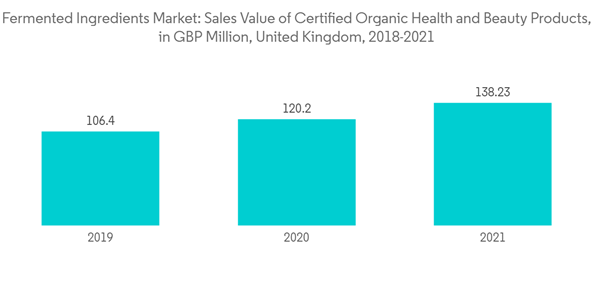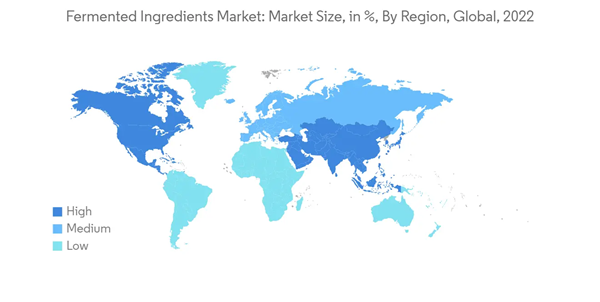The global fermented ingredients market is expected to grow at a CAGR of 4.72 % during the forecast period.
This product will be delivered within 2 business days.
Key Highlights
- The global fermented ingredients market is witnessing an upsurge of rising consumer awareness regarding the benefits in the food and beverage, industrial, and personal care sectors. Additionally, significant growth in the animal feed sector and processed food products, in addition to the rising consumer interest in bio-based chemicals, is expected to propel growth in the fermentation ingredient market.
- Further, producers of bulk food and feed ingredients, such as amino acids, organic acids, and vitamins, use fermentation as the basis of their production. Modern industrial biotechnology processes use carefully selected and purified microbial cell cultures to produce an ever-increasing variety of ingredients and increase productivity. The feed sector is witnessing a boost in the market studied, significantly driven by rising consumption of meat among consumers, which leads to more livestock rearing in the global market, especially in South America, Asia-Pacific, and other regions.
- Moreover, the demand for cultured dairy products is augmenting globally. This demand is led by new product development, improved taste and versatility, and high marketing support, which are expected to boost the overall fermented ingredients market growth in the coming years. Additionally, introducing an eco-friendly production system from fermentation ingredients manufacturers and advanced technologies in the fermentation process will likely change market dynamics during the forecast period.
Fermented Ingredients Market Trends
Increasing Demand for Fermented Ingredients in Cosmetics and Personal Care
- The cosmetics and personal care sector use sufficient bacteria, yeasts, and other fermented ingredients in skincare products to take care of the skin. Fermented ingredients have functional benefits for the overall health of the skin.
- The fermentation process increases the level of antioxidants in each ingredient, which helps slow down the skin's aging process. When used in topical skincare, this fermentation process increases the bioavailability of ingredients, which means that they can be absorbed at a deeper level. This is perfect for anyone with dehydrated skin. The fermentation process maintains the integrity of the ingredients.
- Most unfermented cosmetics are made by heating a mixed formula of ingredients to a high temperature and then cooling them, which can potentially reduce the effectiveness of the active ingredients.
- A fermented ingredient has a more acidic pH, which has a better affinity with the skin (with its naturally acidic pH). In addition, fermented ingredients also have anti-inflammatory properties. The fermentation process makes them rich in enzymes, which are able to soothe and prevent skin inflammation. Further, fermented ingredients in cosmetics and personal care cater to natural, organic, and chemical-free cosmetics, increasing their demand further in the market.
North America Holds the Largest Market Share
- Consumer interest in the potential health benefits of fermented foods and beverages is increasing as they are becoming aware of the benefits offered by fermented products as it improves the digestive system, which influences immunity and brain functions. Thus, boosting the demand for various fermented ingredients such as amino acids, enzymes, etc.
- The amino acid demand in the United States is fueled by increasing consumers' inclination toward high-protein diets for bodybuilding and general well-being. Branched Chain Amino Acids (BCAAs), namely valine, leucine, and isoleucine, are increasingly utilized in performance-nutrition solutions.
- Further, Canadian consumers prioritize basic dietary habits, such as lowering sugar intake and including natural and functional food. This focus on a healthier diet and current purchasing trends drive the demand for fermented ingredients in Canada.
- The dietary supplement sector of the Canadian marketplace has increasingly incorporated amino acids in its product formulations, targeting consumers looking to boost athletic performance or achieve body composition goals.
Fermented Ingredients Market Competitor Analysis
The global fermented ingredients market is fragmented, as domestic players across each region hold most of the share. Major players operating in the region and having a stronghold in the segment are Lonza Group, Ajinomoto Corporation, Cargill Incorporated, Associated British Foods PLC, and BASF SE, among others. The geographical presence is also the main factor that has led these companies to prosper in the fermented ingredients segment. Significant players focus extensively on providing consumers with innovative offerings while including product penetration across most application segments. The leading players in the global fermented ingredients market enjoy a dominant presence worldwide. These players focus on leveraging opportunities posed by the emerging markets to expand their product portfolio to cater to the requirements for various applications, especially in the food and beverage segment and Industrial use.Additional benefits of purchasing the report:
- The market estimate (ME) sheet in Excel format
- 3 months of analyst support
This product will be delivered within 2 business days.
Table of Contents
1 INTRODUCTION
4 MARKET DYNAMICS
5 MARKET SEGMENTATION
6 COMPETITIVE LANDSCAPE
Companies Mentioned (Partial List)
A selection of companies mentioned in this report includes, but is not limited to:
- Lonza Group
- Ajinomoto Corporation Inc.
- BASF SE
- Dohler Group SE
- Cargill Incorporated
- Associated British Foods PLC
- Lallemand Inc.
- Evonik Industries AG
- Kyowa Hakko Kirin Co. Ltd
- Lesaffre
Methodology

LOADING...










